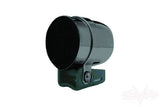Razorback Belt Temperature Gauge:
3.0 Edition Belt Temp Gauge
The Razorback Technology 3.0 Edition Belt Temp Gauge monitors REAL belt temperature and displays current, average, and high temperatures on a LCD screen with multi-color LED alerts. Machined from solid aluminum, this gauge boasts a smaller profile than our other gauges, waterproof connections, and a sensor quick release at the clutch cover.
•Fits 2 1/16” Gauge Clusters/Pods
•Machined from Solid Aluminum Stock
•Anti-Glare LCD Screen
•Multi-Color LED Alerts
•Current, Average, and High Temperature Tracking
•Waterproof Sensor, Connections & Gauge
•Quick Release Sensor Harness
•One Year Warranty
Track Actual Belt Temperature
Razorback Belt Temperature Gauge is the first in the industry to feature infrared sensors that monitor actual surface belt temperature. These infrared sensors are mounted on the removable clutch cover and are aimed directly at the cvt belt. This real-time reading of a belt’s surface temperature allows riders to avoid damaging temperatures and get more miles from their belts. We’ve programmed our gauges with screen inversion or LED alerts to warn riders when their belts reach temperatures at which heat damage can occur, letting them back off before they cook their belts.
Dial-In Clutching
Monitoring actual belt temperature is also a great indicator of clutch tuning and performance. With an infrared belt temperature gauge, riders are able to see exactly how adjustments or modifications impact the load that is placed on their belts. If a belt is heating up faster than normal or fails prematurely, it could be a result of increased friction to the sides of the belt resulting from misaligned clutches. A poorly tuned clutch setup with the wrong weights or a worn out spring could also contribute to belt slippage and generate unneccessary heat. A Razorback Technology infrared belt temperature gauge is an invaluable tool when adjusting clutching.
Monitor Belt Life
When you ride with a Razorback Technology belt temp gauge, you’ll be able to monitor the condition of your belt as you ride. Here’s how:
Watch for how quickly belt temperature fluctuates. If a belt begins to heat up significantly faster from ride to ride, it is clear that belt condition should be a concern going forward.
With our 3.0 Edition gauges, we introduced Average and High Temperature tracking. When the average belt temperature increases by 40-50° F, it is time to start thinking about replacing the belt. Another red flag of expiring belt life is a sudden temperature spike of real-time temperature. A 60-70° F jump usually signals that the belt is about to blow, and it is time to replace the belt before it completely goes.









